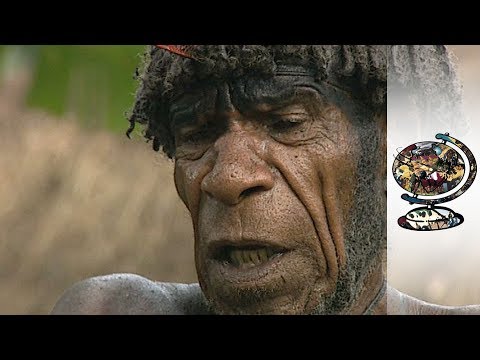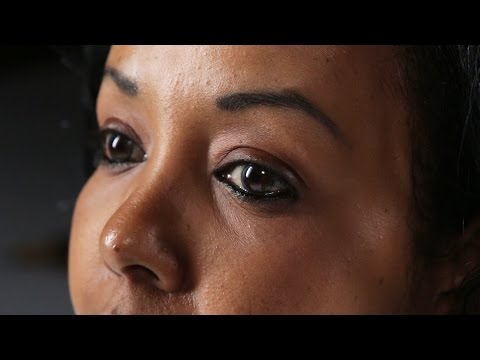The cultures that appreciate body modification are widespread throughout history, and some of them are far more extreme than others. These ten examples are truly some of the most fascinating examples of cultural body modification. See Also:Top 10 Things You Didn’t Know About Yourself
10 Neck Elongation
Neck Elongation is the practice of placing neck rings around a woman’s neck at various points throughout her life to achieve an ideal standard of beauty. Over time, they stack and create the illusion of a long neck, as they don’t physically lengthen the neck. Instead, they push the clavicle and ribs down, making it look as if the neck is longer than it truly is. Over time, the rings’ weight twists the collarbone and upper ribs 45º lower than where they would naturally be. Neck elongation is found in African and Asian cultures, though they are likely best known in the Kayan Lahwi Tribe in Myanmar. Kayan girls wear brass collars as early as two to five years old. Over time, they add rings as the girl ages, creating the bones’ deformity that results in the illusion of neck elongation. The practice was first described to the West by Marco Polo, who wrote about it in 1300 AD. The modification to the body is permanent. While removing the rings is possible, it can result in death if done incorrectly. Simply removing them often causes pain, so for most women, the addition of rings is a permanent choice.[1]
9 Lip Plates
It’s relatively common in the West to see people placing successively larger gauges in their earlobes to create large holes, but the practice isn’t new. In some parts of Africa, increasingly larger disks made from clay or wood are placed into a pierced lower lip (sometimes upper) until a large lip plate can be worn. The practice was independently invented at least six times in Sudan, Ethiopia, Eritrea, Mesoamerica, and Ecuador, with Africans starting as far back as 8700 BC. The placement of lip plates continues in various places around the world, though it is most common in Ethiopia. The Mursi and Surma people who inhabit the lower Omo River valley begin the process about six to 12 months before marriage. This is usually around the age of 15 to 18 when the lip is first pierced. At this time, a wooden peg is inserted. Over time, the peg is replaced by larger pegs, and eventually, a plate is inserted into the hole. The size of the plate depends on any of several factors, though the largest one ever recorded, in 2014, measured 23.4″ (59.5 cm) in circumference and 7.6″ (19.5 cm) wide.[2]
8 Blackening & Filing Teeth
The Bagobo people of the Southern Philippines in Mindanao are an ancient tribe who have inhabited the region for centuries and is credited with bringing Hinduism to the area. While many members of the tribe have embraced modern life, some continue their traditional practices, including sharpening and blackening their teeth as a rite of passage for young Bagobo. Watch this video on YouTube When a Bagabo youth reaches the age of puberty, they have their teeth filed by placing their heads against the person carrying out the sharpening. They then bite down on a stick, and the teeth are filed, leaving only the stump of the tooth, ending in a sharp point. Once the filing is completed, the teeth are then blackened to complete the process. To darken the teeth, powder created from a tree or black smoke passed through bamboo is applied to the teeth, which blackens them. Throughout this process, the person having the treatment done is not allowed to drink any water, nor can they eat sour food. They are also prohibited from attending a funeral, so their less-than-pristine teeth don’t cause offense.[3][4]
7 Circumcision
These days, people don’t often think about circumcision as anything more than a simple medical procedure. Still, the practice has a long history, and it very much is a form of cultural body modification. Circumcision is a form of genital mutilation that involves removing the skin (prepuce) covering the tip of the penis. It’s most commonly performed shortly after birth. In many hospitals throughout the West, it’s common to circumcise a child without any cultural or religious stipulation. Despite this, the practice is deeply rooted in history and has been conducted by numerous cultures around the world. Circumcision and other forms of genital mutilation began in eastern Africa sometime after 3,000 B.C. Early uses of circumcision likely centered around the fact that a man’s foreskin is the location of their primary erogenous sensation. Removing it may have been seen as a sacrifice of enjoyment in life for a potentially better afterlife.[5] The ancient practice was carried into modern times via Jewish customs, which continue to conduct circumcisions on newborn boys, eight days following birth. Judaism ascribes circumcision as a commandment honoring of the covenant between Abraham and God.
6 Scarification
One of the oldest known practices of body modification is tattooing. Still, another similar process of creating images on the skin is called scarification. The process involves cutting, branding, scratching, or etching images into the skin. Doing so creates permanent scars in the desired image. The reasons someone might use scarification over tattooing are various, though there are several potential cultural reasons. They could be done as a rite of passage, for religious reasons, or for social reasons. In that respect, scarification is found more often in dark-skinned cultures, as the resulting images are easier to see than traditional tattoos. There are numerous cultures worldwide, and throughout history, that have utilized some form of scarification for various reasons. It is most commonly found in sub-Saharan Africa, West Africa, and East Africa, including the Gonja, Tiv, and Maasai people. Regardless of the methods used, scarification is inherently more dangerous than tattooing. The skin is subjected to a much larger trauma, and the risk of infection is substantially greater. Additionally, the process takes much longer than tattooing due to the need to heal between treatments.[6][7] See Also: 10 Horrifically Botched Circumcisions
5 Fingertip Removal—Dani Village, New Guinea
There are several instances of fingertip removal across various cultures in history, with Yakuza members being one known to many around the world. Another culture that practices removing portions of the finger is the secretive tribe of the Dani found deep in the jungles of Indonesia. Whenever a loved one dies, female members of the tribe have the upper half of their fingers amputated, in a process called Ikipalin. This is done as part of a ritual meant to ward off spirits. It is believed that removing the upper part of the finger helps to keep the deceased person’s restless spirit away from the family. Additionally, it is meant to be a symbol of the pain of bereavement, and it doesn’t stop with adult women. In some cases, the mothers will bite the tips of the fingers off of their own babies to have them take part in the practice. The Indonesian government banned fingertip removal, but members in Western New Guinea are believed to continue the practice. Older women are often found to be missing parts of their fingers, which suggests Ikipalin continues in some areas of the country.[8]
4 Genital Beading
Genital Beading or Pearling is a form of body modification believed to have originated in Southeast Asia sometime in the early 1400s. A more famous account of Pearling came from members of the Yakuza, who insert a single pearl for each year they are imprisoned. Pearling involves permanently inserting small beads beneath the skin of the genitals. It is most commonly done by men who insert pearls in the penis’ shaft, though women have been known to do it directly under the labia’s skin. There are several reasons a person might do this; however, it is commonly done to enhance sexual pleasure during vaginal or anal intercourse. Historically, pearls were used in the practice, hence the name, though any material can be used, including gold and ivory. In modern times, Teflon, surgical steel, titanium, and silicon are used, as they are the safest option for permanent insertion into the body.[9] These days, it’s common for Filipino sailors, who largely do Pearling to curry favor with prostitutes. “Filipino seaman are famous for them… that’s why they [women in port] like us, why they keep asking for us. When they hear that Filipinos are coming, they’re happy.”[10]
3 Female Genital Mutilation
While removal of the prepuce in boys only lessens their erogenous pleasure during sex, female genital mutilation aims to destroy it altogether. The practice involves the partial or complete removal of the clitoral hood, clitoral glans, inner & outer labia, and the vulva’s closure, leaving a small opening for the passage of urine and menstrual blood. Watch this video on YouTube While most people around the world consider female genital mutilation to be barbaric, that hasn’t stopped it from being carried out on an estimated 200 million women living in Africa, the Middle East, and Asia.[11] The practice began long ago, but the origins remain unknown. It is believed that female genital mutilation may have been practiced in ancient Egypt’s Middle Kingdom period, which would set the custom as far back as 2050 B.C. Evidence has been found in hieroglyphics, though it hasn’t been found on mummies from the period. It is known that Egypt continued the practice well into the 2nd and 3rd-century. Pilio of Alexandria wrote that “the Egyptians by the custom of their country circumcise the marriageable youth and maid in the fourteenth (year) of their age when the male begins to get seed, and the female to have a menstrual flow.”[12]
2 Foot Binding
Foot binding is the Chinese custom of wrapping a young girl’s feet tightly so that over time, they change shape and size. The practice is believed to have originated among upper-class dancers in the 10th century but became popular over time among the elite during the Song dynasty. By the Qing dynasty, the practice spread to all classes in China. When a woman’s feet were bound in this manner, they were considered to be exhibiting a beauty standard called lotus feet. There were various means of carrying out the practice, but the end result was often the same: the feet were smaller and had the toes tucked unnaturally beneath the sole. The process began before the arch fully formed and could begin with girls as young as four. They would begin in the winter months to take advantage of the cold’s numbing effect and soak the feet in a mixture of herbs and animal blood. The nails would then be cut back as far as possible, and bandages were used to tightly bind the feet until the toes broke. Once broken, the toes were held tightly against the foot’s sole, and the arch was then broken. The process was maintained and repeated for years until the foot’s shape was completely altered. Fortunately, the practice concluded in the 20th century.[13]
1 Head Shaping
Head Shaping, or artificial cranial deformation, is an ancient form of body modification that aimed to alter the skull’s formation through flattening or binding. The practice could only be done before a child’s fontanel closing during the normal growth process. Head shaping predates written history, and several cultures around the world have been found to practice it. Evidence has been found in Proto-Neolithic humans’ bones dating as far back as 9000 BC, where skulls have been found to be elongated to a near conical shape. The earliest written record of the process comes from Hippocrates’ writings, who named the Macrocephali (long-heads) as practitioners around 400 BC. In the Americas, the Maya and Incans reshaped their children’s heads, as did some Native American tribes in North America.[14] People in France practiced head shaping until the late 19th century. They would bind an infant’s head in a tight bandage, which was left in place for two to four months. The bandage was replaced with a fitted basket, which would be strengthened as the child grew using metal threads. The Vanuatu people of Tommen Island continued head binding well into the 20th century, though the practice has widely been abandoned in the 21st century.[15] See Also: Top 10 Human Sideshow Freaks Read More: Twitter Facebook Fiverr JonathanKantor.com
























